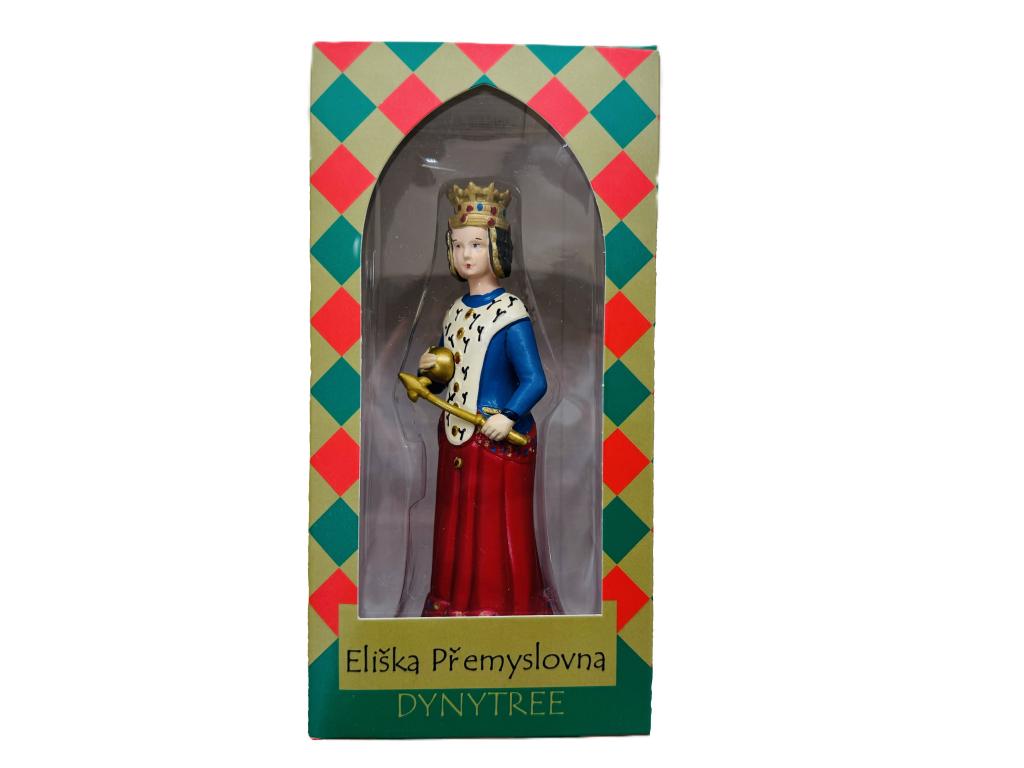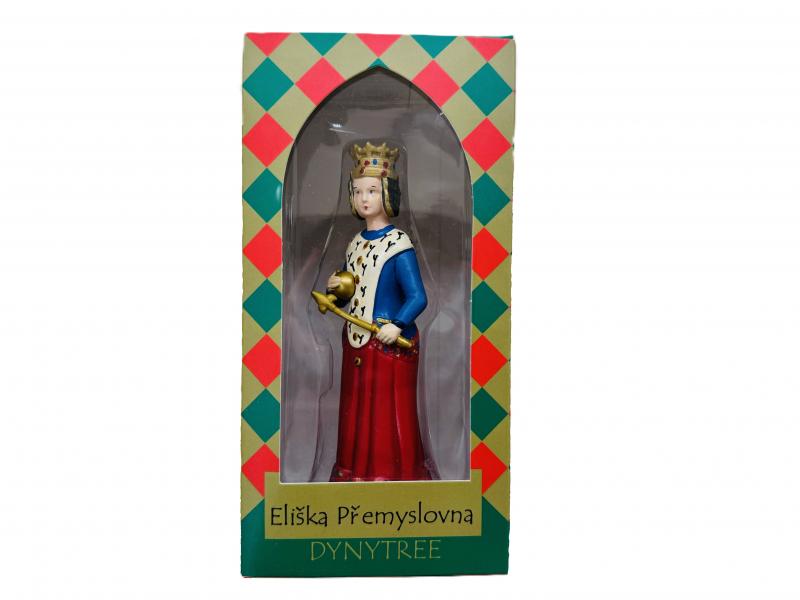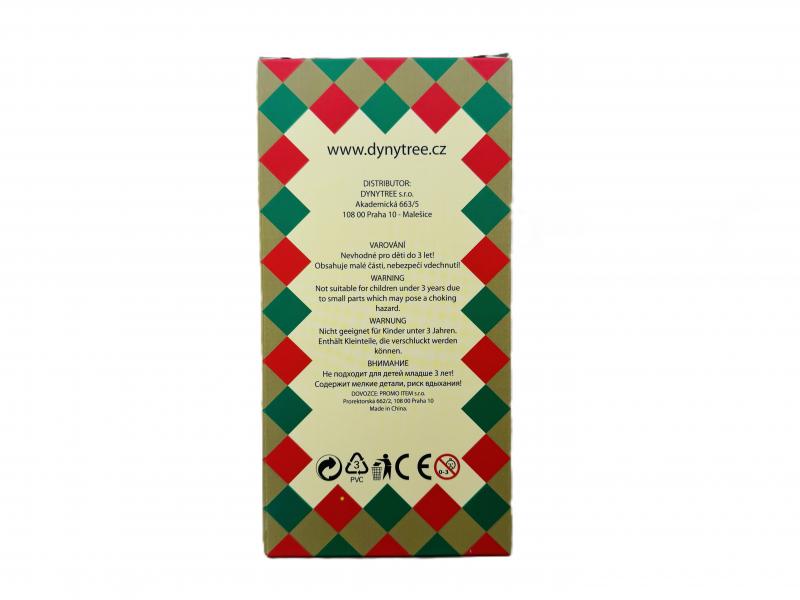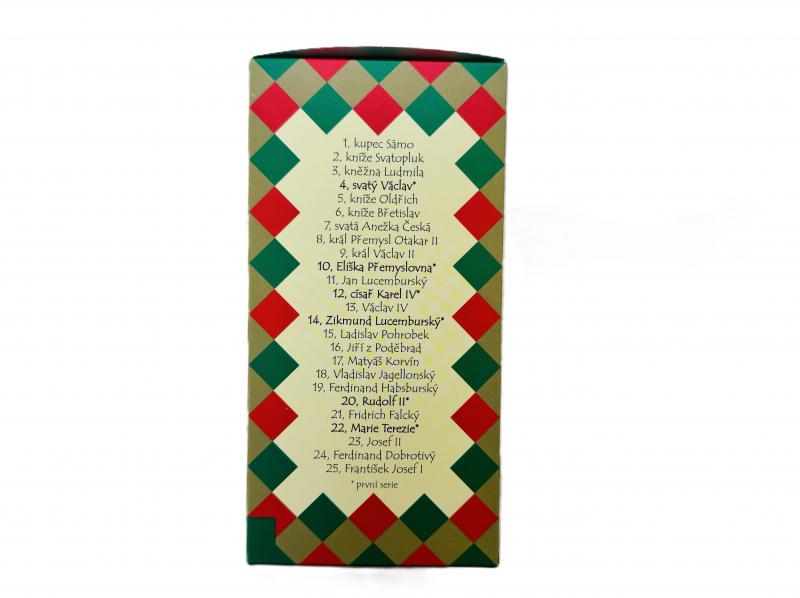K10 Statue of the Elizabeth of Bohemia
Figure of Elizabeth of Bohemia, the last woman of the Přemyslid dynasty on the Czech throne, mother of Charles IV - a gift and souvenir not only for history lovers and visitors to Bohemia. Celý popis
Overview
Figure of Elizabeth of Bohemia, the last woman of the Přemyslid dynasty on the Czech throne, mother of Charles IV - a gift and souvenir not only for history lovers and visitors to Bohemia.
What to Expect
Description:
The figure of Eliška Přemyslovna represents the daughter of the Czech and Polish King Wenceslas II and the last Přemyslovna on the Czech throne.
Details:
The figure is made of plastic, hand painted, 12 cm high, placed in a mica openable packaging and a paper box size 8x8x16 cm. The figure has EC type certificate 110460 T/NB - toy. The figure comes with a leaflet with short information about all 6 figures of the 1st series in Czech, English and German.
Biography:
Wenceslas II, Eliška's father, was the sixth king of Bohemia and the first Polish king of the Přemyslid family. He married Guta Habsburg, daughter of Rudolf Habsburg, and they had ten children together. Eliška Přemyslovna, Wenceslaus III, Anna Přemyslovna and Margaret of Prussia lived to adulthood.
Eliška lost her mother at the age of five and was brought up at Prague Castle in the St. George's Monastery. Her aunt Kunhuta Premyslovna was the abbess of this monastery and it is likely that Eliška was to succeed to the office of abbess. After the death of his wife Guta Habsburg, Wenceslas II remarried to Eliška Rejčka Polská. There may have been a mutual dislike between the stepdaughter and her stepmother, who was about the same age, during these years, which would follow the two women throughout their lives. King Wenceslas II had another daughter, Anezka, with Eliška Rejčka. Wenceslaus II died of tuberculosis in June 1305 and the reign was taken over by Eliška Premyslovna's brother, Wenceslaus III, at the age of 16. He reigns only briefly and historians have different opinions about his reign. According to some, he acted wisely and prudently; according to others, he recklessly carousing, drinking and giving away the crown's property. His reign was abruptly ended by a still unexplained murder on 4 August 1306 in Olomouc. King Wenceslaus III extinguished the Přemyslid dynasty by the sword, because the king did not manage to beget a child with his wife Viola of Těšín.
After the death of the last Přemyslid king, there was a massive power struggle for the succession to the throne of the Bohemian lands. Henry of Carinthia, the husband of Anna Premyslovna, and Rudolf of Habsburg first competed for the kingdom. Rudolf won, and further strengthened his position by marrying the widow of King Wenceslas II, Eliška Rejčka. Rudolf had Eliška Přemyslovna evicted from Prague Castle. Before history had time to get used to the new monarch on the Czech throne from the Habsburg family, King Rudolf called Kaše died suddenly of dysentery on July 4, 1307 during the siege of Horažďovice. This is again the vacant position of the King of Bohemia. The fugitive Henry of Carinthia returns to the throne. In order to get rid of the danger in the person of the adult but still unmarried Přemyslid princess, Eliška Přemyslovna, he wants to marry her off to the insignificant lord Ota of Lobdaburg. With the help of the Bohemian lords, the princess flees Prague Castle. The Czech nobles, dissatisfied with the rule of Henry of Carinthia, ally themselves with the abbots of important monasteries, Heidenreich of Sedlec and Konrad of Zbraslav. The abbots are charged with negotiating the marriage of Eliška Premyslovna to the son of the new King Henry VII of Germany. This chosen groom is John of Luxembourg, who is to become the new King of Bohemia alongside his wife of the Přemyslid family. King Henry had originally proposed that his brother Walram should become Eliska's husband and King of Bohemia. Eliska personally came to Spyr, where she was presented to King Henry and his wife Margaret. The Premyslid princess made a good impression on the royal couple and they agreed to marry their only son, Jan, to Eliška, even though Jan was fourteen years old and Eliška Premyslovna was four years older. The wedding took place on September 1, 1310 in Špýr and subsequently the young couple set off with an army to Bohemia to achieve their throne in fact. Henry of Carinthia and his wife again fled to Carinthia before their military superiority, and Eliska Premyslovna and John of Luxembourg occupied Prague and were crowned king and queen there on 7 February 1311.
The marriage of John and Eliška was not a happy one. Perhaps it was the age difference that bothered John, who saw his wife as more of a guardian than a partner. Perhaps the fact that only two daughters had been born from the marriage so far also played a role. The first son, Wenceslas, the future Emperor Charles IV, was not born to the royal couple until 1316. Eliška tried to exert her influence on the kingdom as much as possible, she wanted to unconditionally restore the power and glory of the Přemyslid family. John of Luxembourg, on the other hand, was disgusted by the reality of the Bohemian lands, the resistance of the nobility and the relative modesty of the local conditions. He began to go on more and more frequent expeditions to foreign lands, where he quickly gained fame and notoriety as a hero and a true knight.
Even at this time, Eliška Přemyslovna did not forget her hated stepmother Eliška Rejčka. After the death of her second husband, Rudolf of Habsburg, Eliška Rejčka lived in the eternal city of queens, Hradec Králové. She became close to the leading Czech nobleman, Henry of Lipá. Thus, two strong antagonistic power groups emerged in the country, one around the double queen dowager and Mr. Henry of Lipá, and the other around Eliška Premyslovna, supported by Mr. William Hare of Valdek. The disputes over power culminated in 1315, when Eliška Premyslovna had Henry of Lipá imprisoned in Týřov Castle. The majority of the nobility sided with Henry, the so-called 'War of the Two Queens' broke out in the country, and Henry had to be released after only six months of imprisonment. The nobility even threatened John of Luxembourg with expulsion from the country and the election of another king. The whole situation had to be calmed down only in 1318 by Ludwig of Bavaria as a negotiator, and the whole conflict ended with the victory of Henry of Linden.
This defeat probably contributed to the collapse of the marriage between Eliška Premyslovna and John of Luxembourg, with John blaming his wife - and probably rightly so - for the escalation of the dispute with his former stepmother. In 1319 the marriage broke down completely, and Eliška and her children took refuge in Loket Castle. John of Luxembourg militarily occupied Loket and took away the three eldest children. Eliška Přemyslovna resisted her husband with an army, and with her ally Vilém Hare of Valdek, she occupied Prague. King John's army attacked the rebels and Eliška was defeated. John of Luxembourg sent his wife into exile to Mělník. Here King John visited her several times and their son Jan Henry was born. At this time, it is said that Eliška Přemyslovna, together with her half-brother Volk, attempted to deprive John of Luxembourg of his life and to install her son Wenceslas in his place. King John found out about the whole affair and Eliška had to flee to Bavaria to escape his wrath. From then on, the royal couple lived as strangers, or rather as open enemies. Eliška Premyslovna died of tuberculosis at the age of thirty-eight on 28 September 1330. This last Premyslovna tried her best to restore and preserve the glory and power of her family, but her probably well-meaning efforts were often spoiled by her short-tempered and vindictive temper.
We know the likeness of Eliška Premyslovna from Jan Parléř's portrait bust, although it was made long after the queen's death. Furthermore, her idealised image is preserved in the illumination of the Zbraslav Chronicle and other contemporary chronicles. Our figure is dressed in the typical attire of noble women of the time, the so-called supot, complete with an ermine bedspread. Queen Eliška's crown is based on the shape of the wedding crown found in the treasure in Silesian Centre and attributed to Eliška Premyslovna.
Availability:
Pick up your product at any time from 09.00 till 16.00 at our office GET PRAGUE GUIDE at Maiselova 5, 110 00, Prague 1 or we can send it to your address via post (the shipping is not included in the price of the item).
Customer service phone number +420 725 744 770
Thank you, your GetPragueGuide




